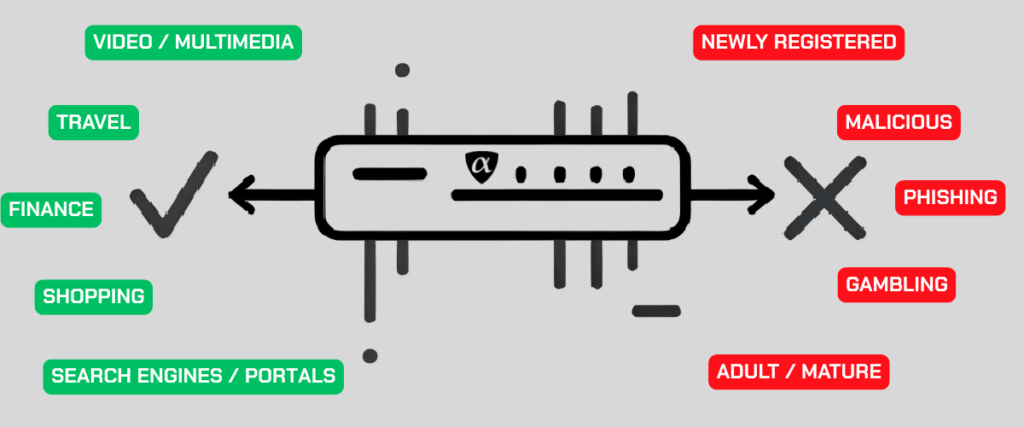If you manage a firewall rule-set, write secure-web-gateway policies, wrangle CASB shadow-IT reports, or simply lose sleep over which URLs your workforce can reach, this web classification guide is built for you. It distills the sprawling, ever-shifting internet into plain-English web content filtering categories—then layers on compliance cues, threat stats, and ready-to-deploy policy moves—so security architects, network engineers, and IT-risk leaders can turn raw domain feeds into smart, defensible access controls without drowning in noise.
How to use this guide
Each web content category listed below also contains a mix of five insight types under “Expanded Guidance” that you can use to inform your security policies and communications. The insights types are:
- Business-impact snapshot – what can go wrong if traffic is left open.
- Compliance call-out – frameworks or laws that may apply.
- Threat statistic – data-backed evidence of risk (sources cited).
- Recommended policy action – a practical default stance.
- User-education tip – talking points for awareness programs.
Feel free to cherry-pick any of these insights when writing your own policy or security-awareness material.
The 89 web categories detailed below are available in the alphaMountain web classification API and feeds which can be licensed to power your secure web gateway (SWG), secure email gateway (SEG), firewall or to enrich their respective logs.
Whether you’re just getting started with web security policies or you know your way around the corporate network, this is the guide for you.

1. Adult-related
| Category |
Expanded Guidance |
| Adult/Mature |
Compliance: Required blocking for K-12 schools and public libraries accepting E-Rate funds under CIPA, which mandates filters for “obscene” or “harmful to minors” imagery. via Federal Communications Commission Policy: Block by default; review unblock requests through HR or legal. |
| Dating/Personals |
Threat statistic: Over half of U.S. online daters (52 %) say they’ve encountered a scammer on these platforms. via Pew Research Center Policy: Allow on guest Wi-Fi only, or require MFA for corporate logins to curb credential reuse. |
| Gambling |
Business impact: Unregulated betting can expose payment data and violate corporate ethics policies. Policy: Block except for regulated wagering desks (e.g., gaming industries) on segregated networks. |
| Lingerie/Swimsuit |
User-education: Remind staff that sharing suggestive images internally can breach harassment policies. Policy: Allow retail checkout paths; block image galleries if workplace culture demands. |
| Mixed Content/Potentially Adult |
Business impact: Ad-heavy meme sites often side-load cryptominers, burning CPU and battery resources. Policy: Quarantine until content review completes. |
| Nudity |
Compliance: Museums and art archives may be permissible for higher-ed or design teams; document exceptions. Policy: Block by default outside approved groups. |
| Pornography |
Policy: Enforce a hard block across all networks; audit logs monthly to detect proxy circumvention attempts. |
| Sex Education |
Compliance: Allow in health-education settings but consider time-of-day rules for minors. |
2. Business-related
| Category |
Expanded Guidance |
| Ads/Analytics |
Business impact: Third-party trackers leak customer identifiers, risking GDPR fines. Policy: Strip tracking parameters or route through a privacy proxy. |
| Auctions/Classifieds |
Threat statistic: Online purchase scams are the single most-reported fraud type, accounting for 30 % of all scam reports to the BBB. via Better Business Bureau Policy: Read-only access; block posting from corporate IPs. |
| Brokerage/Trading |
Compliance: FINRA requires capture of trade-related communications—pair category allow-lists with DLP that inspects chat logs. |
| Business/Economy |
User-education: Encourage trusted news sources; warn against clicking “sponsored” stock tips that may front for pump-and-dump. |
| Finance |
Compliance: PCI-DSS scope may expand if card data traverses to unvetted payment processors—inspect egress. |
| Alternative Currency |
Business impact: Rogue browser wallet extensions introduce significant key-logging risk. Policy: Allow only whitelisted wallets. |
| Job Search |
Business impact: Spikes in résumé uploads can signal insider flight risk—feed telemetry to HR analytics. |
| Marketing/Merchandising |
Policy: Treat unknown SaaS sign-ups as shadow IT; require SSO enforcement. |
| Real Estate |
User-education: Warn finance teams about spoofed title-company domains during closings. |
| Restaurants/Food |
Policy: Allow but throttle bandwidth during peak lunch hours to preserve QoS. |
| Shopping |
Business impact: Embedded promo videos can strain WAN links; apply adaptive bitrate. |
| Travel |
Compliance: GDPR-protected PII often passes through booking engines—enable data-loss checks. |
| Vehicles |
Business impact: VIN-lookup sites can reveal customer data in automotive verticals—treat as regulated. |
| Promotional Compensation |
Threat statistic: “Get-paid-to” schemes frequently seed phishing kits and survey fraud. Policy: Block or isolate. |
3. Entertainment-related
| Category |
Expanded Guidance |
| Arts/Culture |
Business impact: Legitimate for creative roles; whitelist known institutions instead of mass allow. |
| Audio |
Policy: Permit streaming but cap bitrate; block peer-to-peer music sharing to avoid copyright liability. |
| Entertainment (General) |
User-education: Satirical news can mislead brand-monitoring tools; tag feeds to avoid false alarms. |
| Games |
Threat statistic: Cybercriminal lures targeting young gamers jumped 30 % in H1 2024 versus H2 2023. via Kaspersky Policy: Block executable downloads; allow news sites if no binaries served. |
| Hobbies/Recreation |
User-education: Personal blogs may embed trackers—encourage privacy-respected browsers. |
| Humor/Comics |
Business impact: Ad-supported joke sites have a history of drive-by malware—treat with caution. |
| Media Sharing |
Policy: Read-only access; sandbox uploads larger than 25 MB. |
| Sports |
Business impact: Live-stream spikes (e.g., World Cup) can saturate networks—apply QoS. |
| Video/Multimedia |
Threat statistic: Video now accounts for over 82% of consumer Internet traffic. via Cisco Policy: Schedule or throttle high-bitrate content during business hours. |
4. File-related
| Category |
Expanded Guidance |
| File Sharing/Storage |
Business impact: Cloud drives bypass perimeter AV; require inline malware scanning and restrict public-share links. |
| Peer-to-Peer (P2P) |
Compliance: Most enterprises ban torrents to reduce copyright and malware exposure. |
| Software Downloads |
Policy: Route all executables to dynamic sandboxing; deny unsigned installers. |
5. Health-related
| Category |
Guidance |
| Abortion |
Compliance: Vary access by regional laws; log access for legal review when required. |
| Alcohol |
Policy: Permit marketing teams; block direct purchase sites on corporate cards. |
| Health |
Business impact: Tele-medicine platforms handle PHI—enforce TLS inspection and HIPAA logging in healthcare sectors. |
| Tobacco |
User-education: Tie access logs to employee wellness programmes where applicable. |
6. Information-related
| Category |
Guidance |
| Education |
Compliance: FERPA-covered data may traverse LMS platforms—apply DLP rules. |
| News |
User-education: Distinguish reputable journalism from clickbait to reduce social engineering. |
| Reference |
Policy: Allow but monitor paste sites for code or credential dumps. |
| Search Engines/Portals |
Business impact: Anonymous search proxies can evade logging—disable or inspect. |
| Translation |
Compliance: Block on networks handling export-controlled data; machine translation can leak IP. |
7. Online Interaction
| Category |
Guidance |
| Chat/IM/SMS |
Business impact: Shadow chat channels hinder e-discovery—route through archival gateways. |
| Digital Postcards |
Threat surface: Seasonal e-cards are popular phishing vectors—treat as disposable content. |
| Email |
Threat statistic: Financial penalties tied to phishing incidents rose 144 % year-over-year, illustrating growing fiscal risk. via Proofpoint Policy: Enforce DMARC and inline URL detonation. |
| Forums |
User-education: Credentials often surface on breach-forums within days; monitor for brand mentions. |
| Social Networking |
Policy: Allow but inject banners warning against oversharing company data. |
| Telephony |
Business impact: VoIP calls need QoS; block SIP from unknown IP ranges. |
| Virtual Meetings |
Policy: Require meeting passwords and lock screen-share permissions by default. |
8. Other Categories
| Category |
Guidance |
| For Kids |
Compliance: Filtering vendors must prove ≥98 % block rate on adult sites to earn kid-safe certification. via Cybersecurity Dive |
| Personal Sites/Blogs |
Policy: Allow with upload caps; block if site suddenly hosts executable archives. |
| Unrated |
Policy: Quarantine new or unknown domains until automated classification completes. |
9. Potentially Illegal
| Category |
Guidance |
| Child Pornography/Abuse |
Zero-tolerance block; alert law-enforcement liaison on any detection. |
| Drugs/Controlled Substances |
Compliance: DOT-regulated firms must block illicit drug marketplaces. |
| Hate/Discrimination |
Policy: Block and log attempts; forward to HR for potential workplace conduct issues. |
| Marijuana |
Compliance: Align access rules with state or national legality. |
| Piracy/Plagiarism |
User-education: Emphasise legal and malware risks of pirated software. |
| Violence |
Business impact: Repeated access may indicate employee distress—coordinate with HR resources. |
| Scam/Illegal/Unethical |
Threat surface: Advance-fee fraud and fake payment portals are rampant—sandbox suspicious pages. |
10. Security-related
| Category |
Guidance |
| Anonymizers |
Policy: Block; alert SOC when Tor or proxy handshakes appear. |
| Hacking |
Compliance: Allow in controlled labs; block elsewhere to limit accidental tool downloads. |
| Information/Computer Security |
User-education: Legitimate security blogs are valuable; whitelist known vendors. |
| Malicious |
Policy: Auto-block domains listed on threat feeds; review daily for false positives. |
| Parked Site |
Threat statistic: 30.6 % of parked domains transition to a “suspicious” state during their lifetime, far higher than active sites. via Unit 42 |
| Phishing |
User-education: Leverage phishing simulations to measure click-through and reinforce training. |
| Potentially Unwanted Programs |
Policy: Block installers that bundle toolbars or adware; allow only codesigned apps. |
| Remote Access |
Compliance: Log session metadata for forensic readiness; deny unknown RA tools. |
| Spam |
Policy: Route bulk messages through quarantine; enable user self-release after training. |
| Suspicious |
Business impact: Domains exhibiting anomalous TLS fingerprints or WHOIS data warrant heightened monitoring. |
| Newly Registered |
Threat statistic: Over 70 % of newly registered domains are malicious, suspicious, or NSFW—block or closely monitor for 30 days. via Unit 42 |
11. Sensitive Topics
| Category |
Guidance |
| Extreme/Gruesome |
User-education: Provide mental-health resources if logs show repeated access patterns. |
12. Society & Government
| Category |
Guidance |
| Alternative Ideology |
Policy: Monitor rather than block unless content violates local law. |
| Government/Legal |
Compliance: Some communications may be subject to legal hold—retain logs accordingly. |
| Military |
Compliance: ITAR/EAR data may appear; enforce deep-packet inspection on uploads. |
| Non-Profit/Advocacy |
Business impact: Donation forms collect PII—verify SSL certificates. |
| Politics/Opinion |
User-education: Encourage respectful discourse; reference code-of-conduct. |
| Religion |
Compliance: Avoid discriminatory blocks; document rationale for any restrictions. |
| Society/Lifestyle |
Business impact: Lifestyle blogs often house intrusive ad networks; enable tracker blocking. |
| Weapons |
Compliance: Sales of restricted items can trigger export-control obligations—block cross-border transactions. |
13. Technology-related
| Category |
Guidance |
| Content Servers |
Policy: Whitelist trusted CDNs; block unknown edge nodes to thwart domain fronting. |
| Hosting |
Business impact: Shared hosting often harbors malicious sub-domains—score individually rather than blanket allow. |
| Information Technology |
User-education: Encourage staff to verify download hashes from vendor sites. |
| Infrastructure/IoT |
Business impact: Exposed device dashboards can leak operational data—restrict network scans. |
| Productivity Applications |
Compliance: Confirm SOC 2 reports before granting OAuth scopes. |
| URL Redirect |
Threat statistic: 58 % of phishing kits chain through at least one redirect, complicating URL reputation checks. via Cybersecurity Dive |
| AI/ML Applications |
Policy: Apply DLP to prevent prompt leakage of proprietary data. |
| Dynamic DNS |
Business impact: Favored by command-and-control servers; sink-hole unresolved hosts. |
| Login/Challenge |
User-education: Encourage password-manager autofill only on verified domains to reduce phishing success. |
Closing Thoughts
By pairing each of these web content filtering categories with concrete risk context, compliance cues, and default policy stances, security teams can transform a raw block-list into a nuanced, defensible web-access program
A good one balances productivity with protection in 2025 and beyond.


